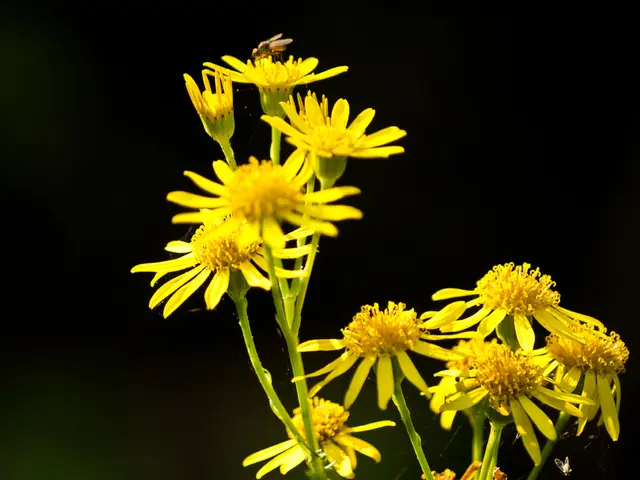14 Varieties of Vegetation to Entice a Diverse Array of Butterflies in Your Backyard
Attracting a Spectrum of Butterflies to Your Garden
Butterflies are a delightful addition to any garden, and with the right plant choices, you can create a haven for these vibrant insects. A diverse mix of nectar-rich flowers for adult butterflies and host plants for their caterpillars is key to attracting various species.
Nectar-Rich Flowers for Adult Butterflies
Native wildflowers such as Joe-Pye weed, coneflowers, goldenrod, and asters provide abundant nectar and are favoured by many butterfly types. Verbena, particularly Brazilian Vervain Verbena, attracts monarchs and other pollinators with its long blooming clusters of small purple/magenta flowers. Tithonia (Mexican sunflower) is notable for drawing many butterflies with its bright orange flowers, while Lantana offers multi-colored, nectar-rich blooms preferred by monarch butterflies. Sweet alyssum, with its fragrant and long-lasting blooms, supplies nectar to a wide range of butterflies and moths.
Host Plants for Caterpillars
Host plants for caterpillars, essential to sustain butterfly populations through all life stages, include parsley and bronze fennel, favoured by Swallowtail butterflies for laying eggs. Butterfly weed (Asclepias species) is essential for monarch caterpillars as both a host and nectar source. Additional host plants like Lady's smock and Bird's foot trefoil support various butterfly and moth caterpillars, contributing to a thriving wildlife garden.
It's important to avoid invasive plants such as non-native fennel, Buddleia (butterfly bush) when non-sterile, thistles, mustard plants, and tropical milkweed in regions where they displace native vegetation and pollinators.
Supporting Butterflies at All Life Stages
By carefully selecting nectar plants, host plants, and blooming varieties, you'll support butterflies at all life stages. The spicebush swallowtail lays eggs on sassafras leaves and uses them as a food source for larvae. Black Swallowtails are attracted to dill, fennel, and parsley, while the sweetbay magnolia is attractive to Eastern tiger swallowtails as both a host and nectar plant. Cabbage Whites are attracted to mustard, thistle, and clover, and Mistletoe is used exclusively by Great purple hairstreaks for laying eggs and as a food source for their larvae.
Lavender is favoured by cabbage white butterflies due to its sweet scent and ample nectar. Painted Ladies are attracted to thistle, verbena, and daisies. To attract butterflies to your garden, plant a variety of flowers with different colors and shapes, avoid using pesticides or herbicides, and provide shelter and resting spots.
Monarchs and More
Monarchs are attracted to milkweed, goldenrod, and asters. Red Admirals are attracted to honeysuckle, clover, and milkweed, while Swallowtails are drawn to zinnias, coneflowers, and purple coneflower. Goldenrod supports migratory monarchs by providing late-season nectar in autumn.
Consider local growing conditions and the plants' unique requirements to keep the butterflies coming back year after year. By following these guidelines, you'll create a garden that's not only beautiful but also teeming with the vibrant life of butterflies.
- A diverse mix of flowers and plants in the garden attracts a variety of butterfly species, enhancing the lifestyle revolving around food-and-drink, home-and-garden, personal-growth, and education-and-self-development.
- With the cultivation of nectar-rich flowers like Joe-Pye weed and Lantana, one can support both adult butterflies and pollinators, encouraging relationships between humans and nature.
- To ensure a successful harvest of butterflies in the garden, one must plant host plants such as parsley and bird's foot trefoil, catering to the needs of caterpillars during their developmental stages.
- Decorating the garden with flowers like Sweet alyssum adds a touch of fashion-and-beauty, while providing additional sources of nectar for various butterfly species.
- To promote the wellbeing of pets, invest in high-quality compost for the garden, which will contribute to healthy soil and, in turn, contribute to the overall health of butterflies and other beneficial insects.
- By incorporating a variety of flowers with different colors and shapes, you create an environment conducive to careers in horticulture and sustainable landscape design.
- Besides attracting butterflies, gardening encourages greater contact with nature, promoting personal growth and overall mental wellbeing.
- Shopping for eco-friendly seeds can support responsible, sustainable practices that not only yield a beautiful garden but also benefit the environment and local ecosystems.
- In addition to butterflies, the carefully curated garden can also attract a myriad of other pollinators, contributing to food production, sports activities, and travel experiences.
- To cultivate a garden that encapsulates a variety of life stages and species, gardeners should monitor and adapt to local weather conditions, ensuring the thriving of their butterflies amidst changing seasonal patterns.
- Cars with fuel-efficient engines consume fewer resources and emit lower levels of greenhouse gases, promoting a greener planet that supports the growth and development of butterflies and their habitats.




